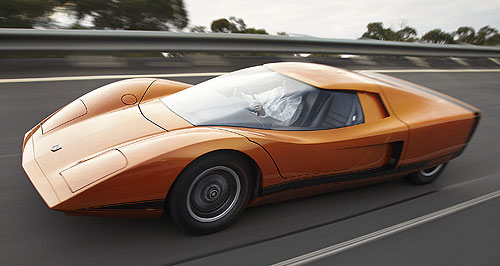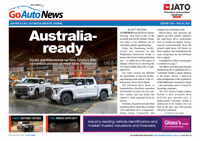Make / Model Search
News - HoldenHolden Hurricane blows up a new stormNew lease of life: Current and former Holden design and engineering staff have collaborated to restore the 1969 Hurricane coupe concept. Curvy concept back to its shiny best as Holden restores classic Hurricane supercar19 Oct 2011 A BACKROOM labour of love has salvaged a valuable piece of GM Holden history, with current and former Holden design and engineering staff collaborating to restore the 1969 Hurricane research car – Holden’s first concept – to its original glory. The one-of-a-kind futuristic two-seat, mid-engined coupe has been painstakingly rebuilt and repainted in its original metallic burned-orange colour in a five-year restoration program that reversed years of neglect and well-intentioned tampering. Arguably the most important concept vehicle produced in Australia, the born-again Hurricane was unveiled today by Holden chairman and managing director Mike Devereux at GM Holden’s Melbourne headquarters. It takes its place there alongside other Holden-developed concepts such as the GTR-X, the VT Commodore Coupe (the forerunner of the Monaro), the ‘Marilyn’ Monaro convertible, TT36 Torana, GMC Denali XT Concept, Cruze Hatch show car and FJ-inspired EFIJY coupe, among others. “This is the reason we are in the auto business and we don’t build pens or computers,” Mr Devereux said before the wedge-shaped car was driven into the foyer of Holden’s headquarters to the applause of hundreds of current and former Holden workers and media. Code-named RD 001 – with the ‘RD’ standing for research and development – the low-slung two-seat coupe is still regarded as a landmark concept car, even in global terms.  Electronic digital display, climate control air-conditioning, rear-vision camera, station-seeking radio, inertia-reel seatbelts and an automated route finder called Pathfinder – a precursor to today’s satellite navigation – were all featured in the Hurricane well before any of those devices made it into a production car anywhere in the world. Electronic digital display, climate control air-conditioning, rear-vision camera, station-seeking radio, inertia-reel seatbelts and an automated route finder called Pathfinder – a precursor to today’s satellite navigation – were all featured in the Hurricane well before any of those devices made it into a production car anywhere in the world.The car was developed as a research vehicle by Holden engineers and designers in a skunkworks at the company’s Fishermans Bend technical centre where, 47 years later, the car was returned in 2006 to be restored in downtime between more pressing jobs. The project was driven by a group of Holden designers, engineers, modellers and fabricators who had been inspired by the Hurricane and wanted to see it paid some respect after a patchy history that included being stored in a crate at Dandenong and used for welding practice at a Melbourne TAFE college. The car was painted silver in the 1980s and displayed at the independent National Holden Museum at Echuca for 11 years until Holden claimed it back in 2006 with the intention of restoring the historic car for its 60th anniversary in 2008. However, the global financial crisis intervened and it has taken until now for the work to be completed in spare time by a team led by Holden modeling manager Paul Clarke and chief studio engineer Rick Martin. The project has even attracted the attention of GM’s vice-president of global design, Ed Welburn, on his periodic visits to Melbourne to check progress on international design projects being done for Chevrolet and Opel by Holden’s design team. Holden chief designer Richard Ferlazzo, who said he took inspiration from the Hurricane, championed the project. GMIO Design executive director Michael Simcoe – who first saw the Hurricane as a boy at the Royal Melbourne Show in 1969 – said Holden had always prided itself on its ability to look into the future through its concept cars. “It is amazing to think that the features we take for granted today were born out of creative minds over 40 years ago,” he said. Mr Simcoe said Holden had carted the Hurricane around dealerships on the back of a trailer, stunning locals in country towns. “It really was a spaceship and a look into Holden’s future,” he said. The rear-drive Hurricane – with the engine mounted behind the two seats and mated with a transaxle transmission – created a sensation in 1969, with its supercar silhouette, doorless design and overall height of just 990mm. To provide access to the car, the roof lifts up and forward electrically on a system of struts, also lifting the steering column out of the way. Capable of sprinting from zero to 100km/h in less than six seconds, the Hurricane was powered by a 195kW 4.2-litre V8 – a forerunner to Holden’s own V8 that later appeared in Holden production cars in 253 and 308 (cubic inch) guises. Holden says the Pathfinder guidance system relied on a system of magnets embedded at intersections, guiding the driver by illuminating arrows in a dash-mounted panel and sounding a buzzer. With no rear window, a rear-view camera gave the driver vision behind the car via a camera embedded in the rear bumper and a small black and white TV screen in the dash. The Hurricane will be displayed at the Motorclassica classic car show at the Melbourne Royal Exhibition Building on October 21-23.  Read more |
Click to shareHolden articlesResearch Holden Motor industry news |











Facebook Twitter Instagram